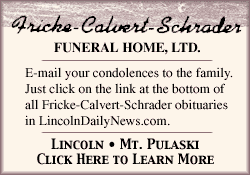|
Emil and Jane were first foster
parents
Emil Stahlhut helped Lincoln
reach excellence in health care
Part
4
[DEC. 11, 2000]
Emil
Stahlhut, the first administrator at Abraham Lincoln Memorial
Hospital, not only set a standard of excellence in health care which
the Lincoln community still enjoys today, he and his wife also found
time to participate in many community activities, including becoming
the areaís first foster parents.
|
|
[click here for Part 1]
[click here for Part 2]
[click here for Part 3]
Emil was charter
president of the United Way in 1961 and has given strong support to that
organization. He was also charter president of the Toastmasterís Club, which
no longer exists; until last year he sang in the Lincoln Area Music Society
chorale; and heís been and still remains an active Rotarian.

"Heís a
past president and one of our oldest living club members," fellow Rotarian
Bob Albert says. "And each year he takes charge of the committee for the
Rotary citrus fruit sale. This is our biggest fund-raiser. Heís done this for
many years. He single-handedly organizes it and does all the paperwork."
"If there was
work to be done on a community service project, he was always willing to give
his time," Jim White, head of the outpatient pharmacy at ALMH, comments.

Emil and Jane also
found time for the very demanding project of being foster parents. In 1972, when
they were still living in a five-bedroom house on Wyatt Street, they began
taking in teen-age girls. The Stahlhuts had four daughters of their own, so
girls seemed the natural choice. They continued in the program for another 19
years, and Jane estimates they had about 200 girls during that time.
"We were
licensed for eight, and we usually had six or seven," Jane recalls.
"Some of them stayed just a week or two, some a few months, some longer.
The average was about a year. One girl stayed eight and a half years, and we
consider her our foster daughter. Her children call us Grandma and
Grandpa."
"We always
had rules and structure, but we had good times, too, and a lot of laughs,"
Jane recalls. "We worked together as a team, and we geared our whole life
around this while we were foster parents."

Larry Evers,
supervisor of the local office of the Department of Children and Family
Services, says Emil was "instrumental in the development of the foster care
programs in our area and Springfield. He served on many committees for Illinois
DCFS and helped form policies.
[to
top of second column in this section]
|

"Jane was
instrumental in developing communication between foster parents and the local
field office. She did foster home visits, explaining the rules of the department
and introducing new foster homes to the caseworkers. Emil was primarily involved
with recruiting new foster homes," Evers remembers.
"Emil and
Jane were an early model of what a foster home should look like. They were the
original foster parents of this community ó
among the most reliable we ever had in terms of longevity and
stability. Emil and Jane opened their home to children with problems when nobody
else was around to do that.

"Without
people like Jane and Emil, the system would not work."
When Emil retired
from his job at ALMH in 1983, he remained active in the community and even took
up a new career. He began remodeling houses, specializing in single-family,
four-bedroom homes. He remodeled 12 of them between 1986 and 1993, renting them
at moderate prices for a while, then selling them. "It was a new learning
experience," he says. "I just couldnít sit around and do
nothing." He also took up marathon running.
In 1994 Emil and
Jane moved to their present one-story home on Ninth Street, where they live
quietly with their two cats, Jack and Jill. Until last year, both taught classes
for foster parents at Lincoln Land Community College. They visit with their four
daughters, Carolyn (Mrs. Gerald Frank) of Springfield, Barbara (Mrs. Melvin
Thake) of Bloomington-Normal, Margaret (Mrs. Michael Webster) of Champaign, Mary
(Mrs. Robert Shattuck of Lincoln, and six grandchildren, three of whom are in
Lincoln.

"I never knew
a person with a more humanistic attitude toward his profession," says David
Sniff, Emilís first administrative assistant. "Peopleís welfare and the
hospitalís welfare were always his first concern. Probably in terms of a
learning experience working with him, I learned more about dealing with people
in a caring way and negotiating skills than I did about the technical side of
hospital administration.
"Emil accomplished so much
because he has always had vision," Sniff continues. "Itís one of
those things you canít teach. The people of Lincoln were luckier than they
knew to get an administrator of his skill, a leader like Emil who would stay and
provide stability and growth for 30 years."
[Joan
Crabb]
|
|
Think
You're Pregnant? WE
CAN HELP.
Free
and Confidential:
Pregnancy Testing. Information and Counseling. Supportive
Services. "A
CRISIS PREGNANCY CENTER"
#5 Arcade Building, Lincoln |
Claire's
Needleworks
and Frame Shop
"We
Frame It All"
On the square
in downtown Lincoln
217-732-8811
M-F 10-5 Sat 10-4
cmstitches@aol.com |
Family
Custom Cleaners
is now open
at 621 Woodlawn.
You
can now stop at our new location to drop off dry cleaning and
do your laundry!
Broadway
Cleaners remains open during this time. |
|
|
|
Ahead
of his time in predicting the trends
Emil Stahlhut helped Lincoln
reach excellence in health care
Part
3
[DEC. 9, 2000]
Emil
Stahlhut, the first administrator of Abraham Lincoln Memorial
Hospital, who stayed in the job for 30 years, contributed a great
deal to this community, and his career brought the area a level of
excellence in health care not often found in a small town.
|
|
[click here for Part 1]
[click here for Part 2]
Another example of
Emilís farsightedness was establishing the outpatient pharmacy. ALMH had an
inpatient pharmacy to provide medications for patients in the hospital but no
facility to provide prescriptions for outpatients. "A lot of hospitals have
done that in the last 10 years," White says, "but we started ours in
1972. It was one of the first in central Illinois."

Emil tapped White,
who was working for the Kroger Family Center, overseeing 27 pharmacies in seven
states and traveling 1,000 miles per week, for the job of setting up the new
pharmacy.
"In those
days we didnít talk about job descriptions. It was, ĎHere it is. You set it
up and operate it.í Emil was an administrator who could delegate
responsibility. It was a skeleton operation at first, only one small room, but
it had a window in the waiting room of the medical group so people could get
their prescriptions right after they saw their doctors.

"In
retrospect, Iím amazed at his ability to pick people," White says.
"He was a genius at picking the right people for the job. There are still a
lot of people at ALMH that Emil hired. And they stayed. One woman worked in the
lab for 35 years, another in medical records for 40."
Jean McCue is
proof of his ability to pick the right people and to keep them. She got
acquainted with Emil when she was helping with the fund-raising campaign, typing
3-by-5 cards. "I was supposed to work for two months. I stayed there for 30
years and loved it," she says.

"When Emil
realized I knew a little about journalism, he asked me to start the hospital
publication," she recalls. "When I started I wondered how I could fill
up four pages. When I left, the bimonthly newsletter was 16 pages." Later
Jean became director of volunteer and special services, and then director of
marketing and development.
[to
top of second column in this section]
|

"Emil was a
great boss. He made employees feel like family. He really cared for the people
who worked for him.
"He knew
firsthand about the changes in health care, and he kept employees informed about
what was going on in the industry, with regular meetings. He was always aware
that for a small hospital to survive, it was important to keep up with the new
technology."

Emil also counts
among his accomplishments helping to support the establishment of the present
Logan County Health Department. He had served on the Logan County Board of
Health and saw the need for a department that had its own tax levy.
"Mr. Stahlhut
was one of an active group of citizens who were responsible for obtaining the
support necessary to establish the health department by referendum in
1970," says Lloyd Evans, present health department administrator.

"This helped
give us the financial support that has allowed the health department to provide
the wide range of service Logan County citizens enjoy today, such as
immunizations for children and adults, WIC (maternal and child health programs)
home-health nursing, and environmental health services designed to protect the
public.

"He also
helped form the mutually supportive relationship that exists between the
hospital and the health department today," Evans says.
"Itís hard to think about our
community now without the health department," Emil comments.
(To be continued)
[Joan
Crabb]
[click
here for Part 4]
|
|
Robert
Prunty
Local cruise and travel consultant
A
member of the
American Society of Travel Agents
509
Woodlawn Road Ė Lincoln
217-732-3486
Click
here to e-mail Robert Prunty |
ABE
LINCOLN
PHARMACY
Just
inside the ALMH front door
Jim
White, R.Ph.
"We
Answer Your Medication Questions."
Click
here to visit our website |
Tell
a friend
about
Lincoln Daily
News.com |
|
|
|
Ahead
of his time in predicting the trends
Emil Stahlhut helped Lincoln
reach excellence in health care
Part
2
[DEC. 8, 2000]
Emil
Stahlhut, the first administrator of Abraham Lincoln Memorial
Hospital, who stayed in the job for 30 years, contributed a great
deal to this community, and his career brought the area a level of
excellence in health care not often found in a small town.
|
|
[click here for Part 1]
From 1955 until
1964, the old Deaconess Hospital had served as a nursing home. But, Jane
Stahlhut remembers, the old building was "just worn out." The decision
was made to build a 100-bed addition to ALMH to become a long-term care
facility. "That was Emilís project all the way," Sniff says.
"He had the help of a professional fund-raiser, but he oversaw the project
while he continued to run the day-to-day business of the hospital." The new
unit opened in October of 1964.

In 1966, 52 of the
100 beds were designated hospital beds. By 1981, because of Medicare funding
ceilings and other cost considerations, ALMH discontinued extended care service.
According to Emil
(and to many of those who know him) one of the highlights of his career was
assisting doctors to form a medical group. "Doctors were the last bulwark
of independent entrepreneurs," he says. "They didnít want to join a
group." But encouraged by Emil and his board, they began to see the
advantage of combining their practices, and in 1972 many doctors who had once
practiced alone joined to form the Abraham Lincoln Medical Group, with offices
in ALMH.

The medical group
was "the way of the future," Sniff says. "Emil saw that the only
way to attract new physicians to a small town was to have an organized group.
That way doctors could provide relief for each other and also share professional
concerns about patients. Physicians coming out of residency were looking for
that. It was the only way to get new young physicians to come to a rural
area."
"Emil was
ahead of his time," says Bob Albert, an old friend and fellow Rotary
member, who has also served on the ALMH board. "He was far advanced in
knowledge of what was going to happen in the future in the field of medicine. He
was well ahead of other administrators, even those in bigger hospitals. He was
aware of programs that could provide government money to benefit the hospital,
and he applied for these funds early on."

Albert also
remembers that Emil had the respect of his peers throughout the state.
"When I was going to hospital functions and meetings at the state level,
wherever administrators were gathered, people would say, ĎYouíre lucky you
have such a fellow as Emil running your hospital.í"
[to
top of second column in this section]
|

Sniff
agrees that the ALHM administrator was very well respected in the
industry. "Emil was a member of the Illinois Hospital
Association Board of Trustees for several years. He was also on the
Illinois Department of Public Health Hospital Licensing Board, an
appointment by the governorís office. Those are prestigious
positions. Iím sure he had opportunities to go elsewhere and chose
not to. He found satisfaction in what he did and the people he
worked with," Sniff says.

"A
lot of very positive things happened as a result of the formation of
the Abraham Lincoln Medical Group," says Jim White, manager of
the outpatient pharmacy at ALMH. The medical group brought together
doctors who had been practicing alone to practice together at ALMH.
(Later the doctorsí group moved out of the hospital and became the
Family Medical Group.)
"It
provided the base to attract new talent and helped us get
specialists to come to our small, rural community. In the early
days, if a patient wanted to see an orthopedic surgeon or a
dermatologist, that patient would have to go to a bigger city. With
the group, different specialists found it was worth their time to
come here once a week to see patients. This was especially good for
older people.
"Also,
because of the formation of the group, we had physicians on-site and
had 24-hour coverage in the emergency room. Early on, Emil saw that
a hospital needed that. And Emil, Dr. Gene Blaum and Tom Yokum were instrumental in setting up a very progressive,
well-trained paramedic system," White explains.

"In the early days,
paramedics were employees of the hospital. When not giving care at
the scene, they worked in the emergency room. But even though they
are no longer part of the hospital, the standard of excellence of
the paramedics in Lincoln and Logan County is still alive and well.
If you go to other communities and assume you will find the same
level of expertise, you may be disappointed. The standard was
established in Emilís time, and today we still enjoy that standard
as a community."
(To be continued)
[Joan
Crabb]
[click
here for Part 3]
|
|
Lincoln
Ag Center
1441 State
Route 10 East
Lincoln, IL
217-732-7948
We
support Lincolndailynews.com!
Click
here to visit our website!!! |
Blue
Dog Inn
111 S. Sangamon
217-735-1743
Open
for Lunch Mon.-Sat.
Open for Dinner Tues.-Sat.
Click
here to view our
menu and gift items |
25
Cents per
Gallon
Self-vendored
reverse osmosis water
The
Culligan
Fresh Water Station
318
N. Chicago St., Lincoln |
|
|
|
ALMHís first
administrator
Emil Stahlhut helped Lincoln
reach excellence in health care
Part 1
[DEC.
7, 2000] Before
Emil Stahlhut and his wife, Jane, came to Lincoln in May of 1953,
they hadnít stayed anywhere longer than three or four years. Emil
had served in the United States Army in World War II, earned a
degree in a new field, hospital administration, and worked in this
new profession at three different Midwest hospitals. But when they
got to Lincoln the Stahlhuts put down roots, and not only Abraham
Lincoln Memorial Hospital but the entire Lincoln community has
reason to be grateful.
|
|
Emil came as CEO
of the old Deaconess Hospital, specifically to oversee the merger of Deaconess
with the new Abraham Lincoln Memorial Hospital. Deaconess, located at the corner
of Seventh and Maple Streets (on what is now a parking lot), had opened its
doors in 1902.
Before World War
II, the Deaconess board had started planning to expand the hospital, but during
wartime no new building projects were possible because all of Americaís
resources were needed for the war effort. But in 1948, with the Hill-Burton Act,
federal money became available to build hospitals in rural areas. The Deaconess
board set out to hire a professional administrator, one who had education and
experience. Emil Stahlhut met all their qualifications.

Abraham Lincoln
Memorial Hospital, with Emil at the helm, opened on April 8, 1954, with a
maternity ward, a surgery ward and 100 beds. And instead of staying three or
four years, Emil stayed for 30, retiring in 1983 after a career that brought the
Lincoln area a level of excellence in health care not always found in a small
rural community.

Emil was born on a
farm in Madison County. After graduating from Edwardsville High School, he went
to Elmhurst College in Elmhurst. There he met Jane Sherman of Oak Park. They
were married in 1941, and he was drafted into the U. S. Army in 1942, after he
had finished all the work for a masterís degree in social work except for his
thesis.
[to
top of second column in this section]
|

"The
Army didnít know what to do with a social worker, so they put me
in the medical department," he says. He became a captain in the
Medical Administration Corps, and, he remembers, "By the time I
got out of the Army I had been in the medical field longer than in
social work."
A new
field was opening up, and Emil was interested, so he got a degree in
hospital administration at Northwestern University in Evanston. He
served as a medical administrative officer at Hines Veterans
Hospital in Maywood, then went to Mount Sinai Hospital in Chicago as
assistant administrator. After that, the Stahlhuts went to
Maquoketa, Iowa, where Emil opened a hospital. They stayed for three
years, then came to Lincoln.

When he became the
administrator at Abraham Lincoln Memorial Hospital (ALMH), Emil
"did it all," says David Sniff, his first administrative
assistant. "From the opening of the hospital until 1963, when
Jim LaMothe became the first fiscal officer, Emil did everything,
from payroll to ordering supplies and drugs to the finances ó
whatever had to be done," Sniff recalls. "He was very
disciplined, very hardworking." (Sniff himself came on board in
1974, left in 1980, then came back in January of 1983, when Emil
retired, and stayed until 1995.)
(To be continued)
[Joan
Crabb]
[click
here for Part 2]
|
|
|
|

